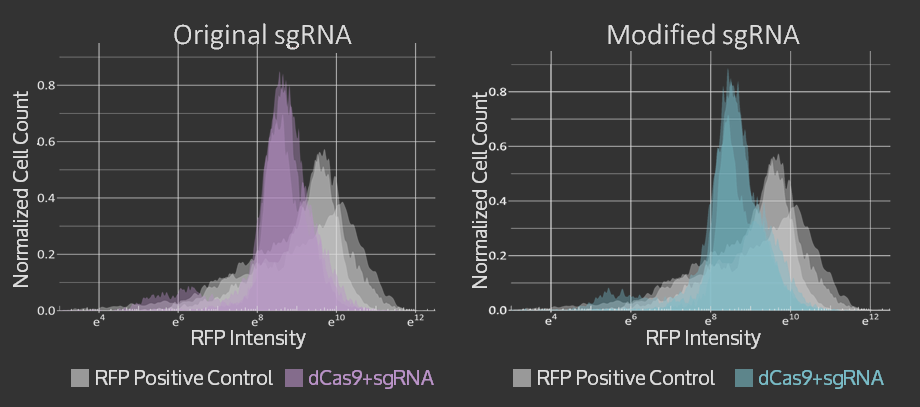Difference between revisions of "Team:Waterloo/Lab Overview"
m |
(add sgrna graph) |
||
| Line 11: | Line 11: | ||
<h2>sgRNA Modification</h2> | <h2>sgRNA Modification</h2> | ||
<p> | <p> | ||
| − | + | <p>For the Simple sgRNA Exchange, we were able to show that adding restriction sites and a single mutation in the scaffold region of the sgRNA <strong>did not reduce targeting</strong> of the sgRNA in CRISPR dCas9 system. The graphs of flow cytometry data can be seen below and more details on the results are available on the <a href="https://2015.igem.org/Team:Waterloo/Lab/sgRNA">sgRNA Exchange page</a>. | |
| + | </p> | ||
| + | <figure> | ||
| + | <img src="/wiki/images/0/09/Waterloo_flowcytometryresults.png" alt="CRISPR-Cas9 structure and project overview" /> | ||
| + | <figcaption>RFP Intensity after targeting with dCas9 + standard sgRNA and dCas9 + modified sgRNA in blue. Non-targeted RFP control measurements are shown in grey. Replicate measurements taken on three separate days are overlayed on the same axes.</figcaption> | ||
| + | </figure> | ||
</p> | </p> | ||
</section> | </section> | ||
Revision as of 22:08, 20 November 2015
Wet Lab Overview
This summer Waterloo iGEM worked on making the CRISPR system more flexible and expand its applications. The wet lab focused in three aspects of this. A design of the modified sgRNA have been proposed in order to add restriction sites to exchange the target using classical cloning. In addition, Waterloo iGEM attempted to mutate dCas9 to recognize different PAM sites. Furthermore, we expanded the CRISPR-Cas9 system’s applications for eukaryotic systems, using Arabodopsis thaliana as the model organism. For more details on the design visit the links below.
sgRNA Modification
For the Simple sgRNA Exchange, we were able to show that adding restriction sites and a single mutation in the scaffold region of the sgRNA did not reduce targeting of the sgRNA in CRISPR dCas9 system. The graphs of flow cytometry data can be seen below and more details on the results are available on the sgRNA Exchange page.
